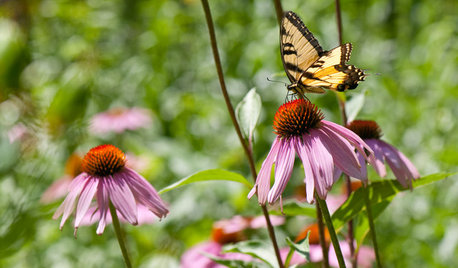Butterfly and moth encyclopedia...book recommendations
perennialfan273
12 years ago
Related Stories

GARDENING GUIDES6 Plants That Beat Butterfly Bush for the Wildlife Draw
It's invasive, a nonnative and a poor insect magnet. Check out these better alternatives to butterfly bush in the garden
Full Story
FLOWERS AND PLANTSHelp Monarchs and Other Butterflies by Planting Common Milkweed
Summer-blooming Asclepias syriaca is an important larval host plant for the monarch butterfly and attracts a number of pollinating insects
Full Story
GARDENING FOR BUTTERFLIESBe a Butterfly Savior — Garden for the Monarchs
Keep hope, beauty and kindness alive in the landscape by providing a refuge for these threatened enchanters
Full Story
GARDENING FOR BUTTERFLIESButterfly Gardening: Delight the Eyes With Living Sculptures
Surprise and thrill with a garden that attracts magical winged creatures, bringing color, movement and life
Full Story
CALIFORNIA NATIVE PLANTSGreat Design Plant: Asclepias Is Attractive to Monarch Butterflies
Increase monarch butterfly populations in California by planting stunning native milkweeds
Full Story
GARDENING GUIDESEntice Eastern Tiger Swallowtails With Summer Flowers
Grow nectar-rich native bloomers and larval host plants for these endearing butterflies
Full Story
GARDENING FOR BUTTERFLIESGarden for Wildlife to Reap Rich Rewards
When you plant with animals and insects in mind, you make gardening easier, the planet healthier and yourself more present
Full Story
GARDENING FOR BUTTERFLIESGardening for the Bees, and Why It’s a Good Thing
When you discover how hard bees work for our food supply, you may never garden without them in mind again
Full Story
GARDENING GUIDESHow to Find the Right Native Plants for Your Yard
Find plant maps, sale sites and guides that make going native in the garden easier than ever
Full Story
GARDENING GUIDESAttract Hummingbirds and Bees With These Beautiful Summer Flowers
Roll out a welcome mat for pollinators to keep your landscape in balance and thriving
Full Story






MissSherry
larry_gene
Related Professionals
Wrentham Landscape Architects & Landscape Designers · Coram Landscape Contractors · Downey Landscape Contractors · Dudley Landscape Contractors · Munster Landscape Contractors · Muttontown Landscape Contractors · Suitland Landscape Contractors · Tacoma Landscape Contractors · Winter Gardens Landscape Contractors · Hueytown Landscape Contractors · Cherry Hill Fence Contractors · Evanston Fence Contractors · Fort Lauderdale Fence Contractors · Rutherford Fence Contractors · Verona Fence ContractorsKC Clark - Zone 2012-6a OH
larry_gene
wifey2mikey
mechelle_m
christie_sw_mo
KC Clark - Zone 2012-6a OH
madame_butterfly123
KC Clark - Zone 2012-6a OH
dragonflydee
KC Clark - Zone 2012-6a OH
dragonflydee